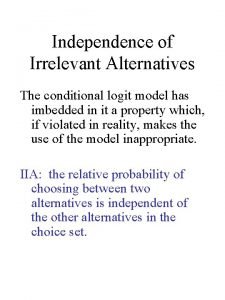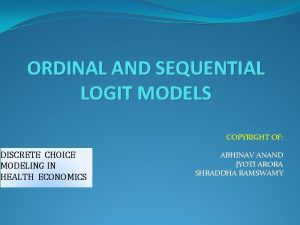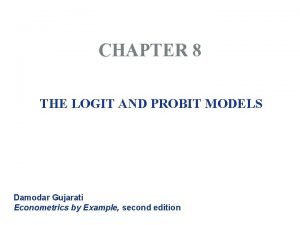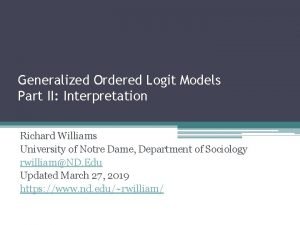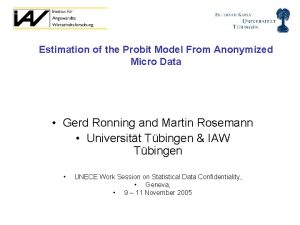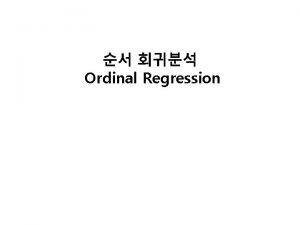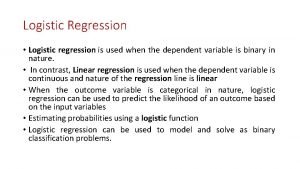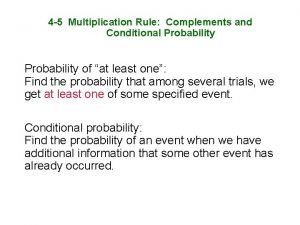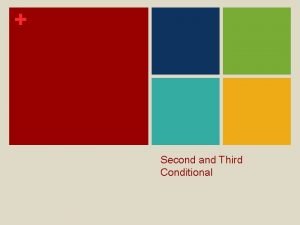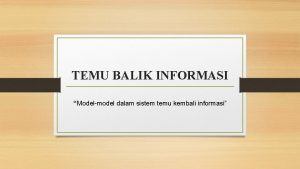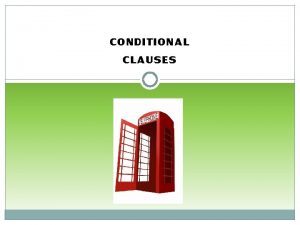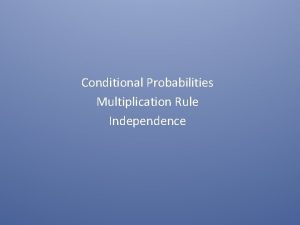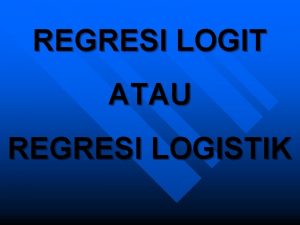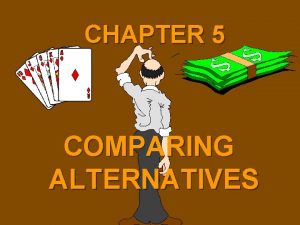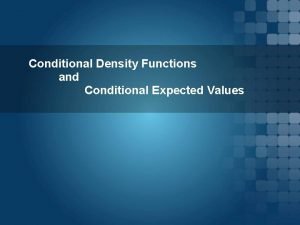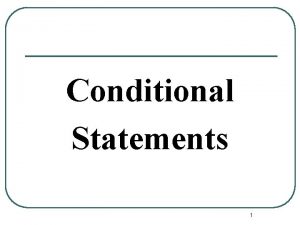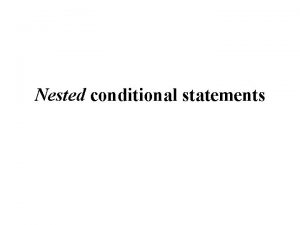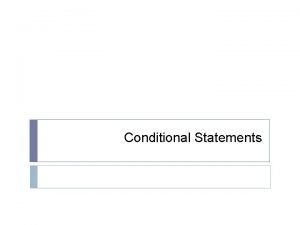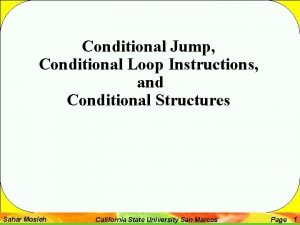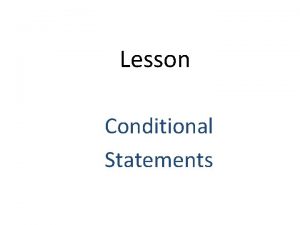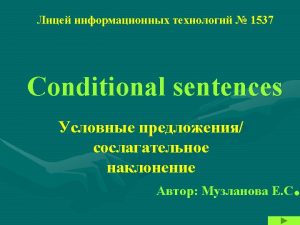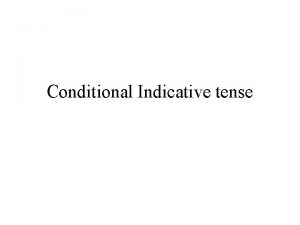Independence of Irrelevant Alternatives The conditional logit model




























- Slides: 28

Independence of Irrelevant Alternatives The conditional logit model has imbedded in it a property which, if violated in reality, makes the use of the model inappropriate. IIA: the relative probability of choosing between two alternatives is independent of the other alternatives in the choice set.

Interpretation of Coefficients in RUMs Note that effect of change in attribute of site j on the probability of choosing site k is independent of all other alternatives.

Evaluating some marginal effects… Example: what’s the effect of an increase in the time costs of accessing site 1 by one hour? Change in Probability Choice=Site 1 4. 67 -26. 153 Choice=Site 2. 572 6. 168 Choice=Site 3. 572 5. 506 Elasticity Choice=Site 4 6. 068. 572 constant elasticity over all other sites The with a change in the time cost of site 1 is. 572 a Choice=Site 5 8. 411 result of the IIA property. -

Testing for Violations Hausman and Mc. Fadden have developed a test for violations of the IIA restriction: Based on comparison of results when the model is estimated a) in unrestricted form and b) with one alternative excluded. Using the St. Lucia model, evidence that we have violation of IIA.

Using Nested RUMs One potential solution to violations of the IIA restriction is to nest or group alternatives, such that substitution within a group is fundamentally different from substitution across groups. IMPORTANT: Independence of irrelevant alternatives will be a property that is forced to hold within any given “nest” but not across nests.

Setting up a Possible Nested RUM for the St Lucia Problem St Lucia Choice Problem Car Mode Bus Mode Walking S 1 S 2 S 3 S 4 S 5 S 1, …, S 5 are the 5 different sites

Some Notation To illustrate, let’s subscript the “top level nest” with k and the “bottom level nest” with j. There are Jk bottom level alternatives associated with top level alternative k. k=1 car mode k=2 bus mode k=3 walk mode J 1 = 5, there are 5 sites available to the individual when he drives J 2 = 5, there are 5 sites available to the individual when he takes the bus J 3 = 5, there are 5 sites available to the individual when he walks

There all sorts of ways to nest decisions. An example for another type of problem: Choice among hiking sites Forested Sites Site F 1 Site F 2 Site F 3 Site F 4 Shoreline Sites Site S 1 Site S 2 Site S 3

The Nesting Structure is a Strategic Modeling Decision • Sometimes the order of the “tree structure” is obvious – • When it is not, the results can be sensitive to ordering.

The Nesting Structure is a Strategic Modeling Decision Sometimes the ordering of nests is obvious: Choice among hiking sites Forested Sites Shoreline Sites Site F 1 Site F 2 Site F 3 Site F 4 Site S 1 Site S 2 Site S 3 But sometimes it is not - such as our case. The results can be sensitive to ordering of nests.

The Logic of the Nested Logit is the Same The utility accruing to individual i if he chooses mode=k, site=j is: Where the Vi(j, k) is a function of the attributes of the jth site and of the kth mode. is assumed to be distributed as generalized extreme value.

An individual’s contribution to the likelihood function is his probability of selecting the alternative that he is observed to select: m is a scale parameter that can vary for different nests. It reflects the degree of substitutability across nests. If ’s = 1 then collapses to simple, unnested RUM.

A Modification of the Utility Function To illustrate assume a simple modification to the form of V(j, k): Travel cost, time cost, and beach size vary over all sites, sik is a variable that has a significance for mode choice – sik = 1 for k=car and i owns a car; sik = 0 otherwise

Partitioning the Probability for Ease of Interpretation Pr(j, k) = Pr(j|k) * Pr(k) Im is known as the inclusive value and m is the inclusive value parameter

Results from A Nested Specification BTIMECB=coefficient on time cost for car, bus BTIMEW = coefficient on time cost for walking BPIGCB = coefficient on Pigeon Pt site for car, bus BPIGW = coefficient on Pigeon Pt site for walking Estimates of Inclusive Value Parameter, m ’s are significantly different from 1, not 0.

Welfare Measurement Using the Nested RUM If valuing a price change at one or more sites: Estimate for loss due to $5 parking charge is now $1. 25 person per choice occasion.

Welfare Measurement Using the Nested RUM If valuing elimination of one or more sites:

WTP for Loss of Sites: Note: Eliminating both sites 4 and 5 simultaneously produces more of a loss than the sum of the two individually, because fewer substitutes to switch to.

WTP per Choice Occasion… All of the measures we’ve gotten to this point are WTP per individual per choice occasion What does that mean?

Per choice occasion really means “per trip” in this model. But trips are an endogenous decision! It is possible that if quality changes or sites disappear, individuals may change the number of trips taken. So, how do we calculate the total gains/losses?

Problem: We have a WTP/trip for the change. We might be able to calculate the change in number of trips due to the exogenous change (quality or site loss) But can not logically solve for total change in WTP from this information.

Alternative Solutions in the Literature • Kuhn-Tucker model(Phaneuf, Herriges, and Kling ) Completely consistent and utility theoretic, but very difficult to do. • Repeat Logit Model – (Morey) Depends on identifying “choice occasions” when individual chooses not to take a trip. • “Linked Trip and Site Choice Model – Ad hoc linking of RUM and demand function for trips model

Combine RUM and Single Site Model The link between these two models is the inclusive value calculated for the initial and subsequent situations.

The Linked Model 1. Estimates the RUM model on site choice. 2. Calculate for each individual, the inclusive value, Ii 0, (which is an index of utility) for the recreational choice occasion. 3. Estimate a demand for recreational trips model, irrespective of site chosen. This takes the form: Where zi = total trips by i Ii 0 is i’s inclusive value si are socio-demographic variables of i

Points to Note • The inclusive value captures all the information about costs and quality from the set of alternatives each individual faces • The model must be estimated using one of the truncation approaches – e. g. the truncated or endogenously stratified Poisson Model. • To do this, you must have total trip data for the individuals you intercepted.

Results of Poisson Model Note: Income variables are dummy variables for categories, leaving out the very high income category. Interpretation is effect relative to very high income group.

Some Useful References General: Haab, T, and K. Mc. Connell, 2002, Valuing Environmental and Natural Resources: The Econometrics of Non-Market Valuation, Edward Elgar. Herriges, Kling, and Phaneuf. 1999 In Valuing Recreation and the Environment: Revealed Preferences Methods in Theory and Practice Greene, William, LIMDEP 7. 0, Choice Sets: Ben-Akiva and Lerman. 1985. Discrete Choice Analysis. Haab and Kicks. 1997. Journal of Environmental Economics and Management. Parsons and Hauber. 1998. Land Economics. Peters, Adamowizc, and Boxall. 1995. Water Resources Research Hicks and Strand. 2000. Land Economics Parson, Plantinga and Boyle. 2000. Land Economics

Nonlinear Income: Herriges and Kling. 1997. Review of Economics and Statistics Nesting Structures: Kling and Thompson. 1996. American Journal of Agricultural Economics Linking Discrete and Continuous Models: Phaneuf, Herriges, and Kling. 2000. Review of Economics and Statistics Morey, Rowe and Wateson. 1993. American Journal of Agricultural Economics Bockstael, Hanemann, and Kling. 1987. Water Resources Research Mixed Logit (Random Parameters Logit): Train. 1999. In Valuing Recreation and the Environment: Revealed Preferences Methods in Theory and Practice
 Independence of irrelevant alternatives example
Independence of irrelevant alternatives example Logit model specification
Logit model specification In gujarati
In gujarati Interpretation of linear probability model
Interpretation of linear probability model Logit model
Logit model Cauchit link function
Cauchit link function Variable dependiente binaria
Variable dependiente binaria Logistic function
Logistic function Logitone
Logitone Modelo multinomial
Modelo multinomial At least one probability
At least one probability Conditional independence machine learning
Conditional independence machine learning What is first conditional statement
What is first conditional statement Conditional in the past
Conditional in the past Binary independence model
Binary independence model Hình ảnh bộ gõ cơ thể búng tay
Hình ảnh bộ gõ cơ thể búng tay Ng-html
Ng-html Bổ thể
Bổ thể Tỉ lệ cơ thể trẻ em
Tỉ lệ cơ thể trẻ em Chó sói
Chó sói Tư thế worm breton
Tư thế worm breton Chúa yêu trần thế alleluia
Chúa yêu trần thế alleluia Các môn thể thao bắt đầu bằng từ đua
Các môn thể thao bắt đầu bằng từ đua Thế nào là hệ số cao nhất
Thế nào là hệ số cao nhất Các châu lục và đại dương trên thế giới
Các châu lục và đại dương trên thế giới Công thức tiính động năng
Công thức tiính động năng Trời xanh đây là của chúng ta thể thơ
Trời xanh đây là của chúng ta thể thơ Cách giải mật thư tọa độ
Cách giải mật thư tọa độ 101012 bằng
101012 bằng
